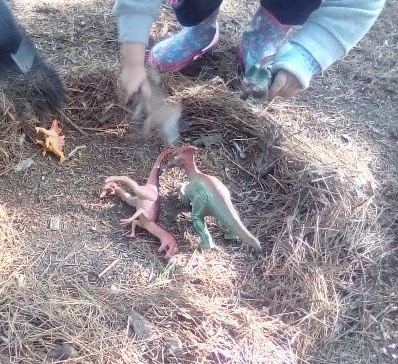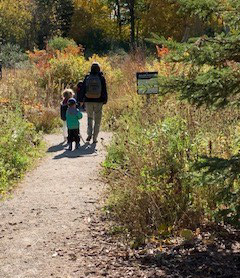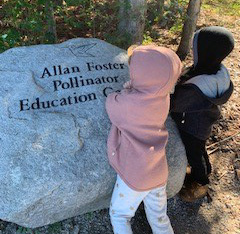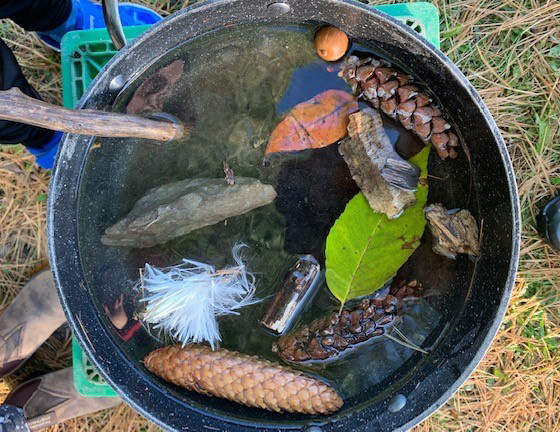Fall 2020
Posted by Victoria
And so we begin!
While it was a slower start than usual, with all the changes and uncertainty that 2020 has brought, the children have made connections with the teachers, with each other, and with our beautiful Nature School space. We’re now truly on our way to an exciting year of play and learning.
The fallen pine needles that carpet our Nature School outdoor classroom have been a big hit. The children have worked together to clear pathways and have made huge mounds of them. Some shoveled, while others dumped the wheelbarrow. In the process, they learned how to work together, to solve disputes, to articulate their visions, and to listen to others.
 Hiding our plastic dinosaurs in the pine needles, or in our life-sized plastic goose, was an ongoing game. (The goose has a big hole on its underside). Just as soon as they were hidden, the children would “discover” them again. It never failed to delight!
Hiding our plastic dinosaurs in the pine needles, or in our life-sized plastic goose, was an ongoing game. (The goose has a big hole on its underside). Just as soon as they were hidden, the children would “discover” them again. It never failed to delight!
Along with the joy of finding the dinosaurs came the understanding that things could be out of sight but not disappear altogether — a very reassuring game for those worried about whether caregivers would return for pick-up time.
Experiencing fall and enjoying all of its beauty has been a constant theme on our walks. We’ve examined leaves closely and talked about their changing colours.
 M. told us that chlorophyll was what made leaves green, and that in the fall the chlorophyll goes from the leaves. S. observed that many of the leaves were more than one colour, and we had a noisy discussion naming those colours. We came up with: orangey-yellow, reddy-orange and yellowy-green.
M. told us that chlorophyll was what made leaves green, and that in the fall the chlorophyll goes from the leaves. S. observed that many of the leaves were more than one colour, and we had a noisy discussion naming those colours. We came up with: orangey-yellow, reddy-orange and yellowy-green.
Young children are pretty concrete thinkers, so this kind of abstraction was interesting to witness.
J. noticed, too, that often leaves changed colour except for a bit that remained green in the middle. K. said that was because the chlorophyll was still in the middle but not on the outside of the leaf. J. suggested that the colour change happens from the outside edge of a leaf and moves toward the middle.
 We’ve found lots of seeds and talked about their amazing adaptations: milkweed seeds that blow in the wind, acorns and pinecones that get hidden by squirrels, burs that attach onto clothing and maple keys that spiral down to the ground. We walked to the Allan Foster Memorial Garden and had a wonderful time finding seeds and playing hide-and-seek.
We’ve found lots of seeds and talked about their amazing adaptations: milkweed seeds that blow in the wind, acorns and pinecones that get hidden by squirrels, burs that attach onto clothing and maple keys that spiral down to the ground. We walked to the Allan Foster Memorial Garden and had a wonderful time finding seeds and playing hide-and-seek.
O. has bonded with slugs this fall, looks carefully after them, and has an uncanny knack for finding them too. We’ve looked at slug trails on the burdock leaves, and some of us have learned to read the stories they leave behind.
Following O.’s lead, we’ve looked under logs to find other creatures and have discovered worms and millipedes.
 And of course there are the puddles. Not only good for jumping, but also for a game of sink or float, and all the predicting and hypothesizing that goes along with it.
And of course there are the puddles. Not only good for jumping, but also for a game of sink or float, and all the predicting and hypothesizing that goes along with it.
We’ve learned, too, that we can measure the depth of the puddles by seeing how much of our boots disappear into the water. And we’ve measured with sticks too. We’ve compared sizes of sticks, and J. and E. counted how many times a small stick measured into a big one.
On one of our walks last week, R. observed that a mossy log was so soft that it crumbled between the fingers. “It feels like soil,” she said — and then with wonder, “Maybe this is where soil comes from.”
And so, like the scientists they are, the children are combining what they know with what they observe, and coming up with very credible hypotheses, so that the learning unfolds in wonderful and organic ways.
